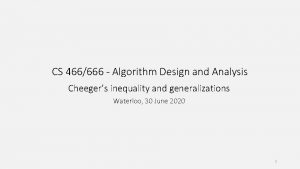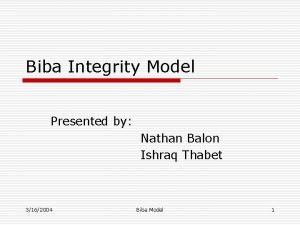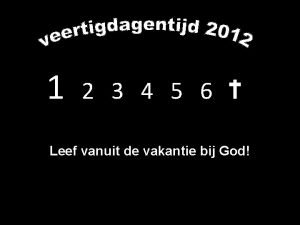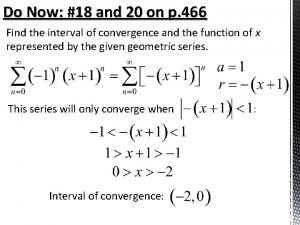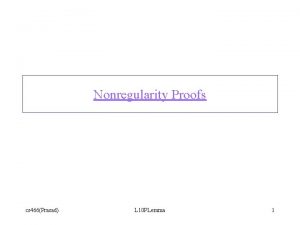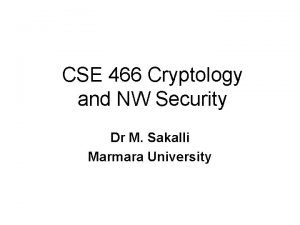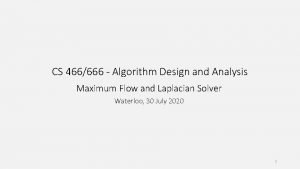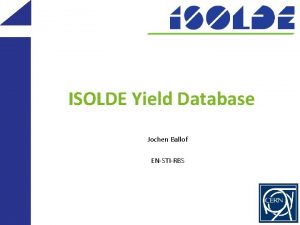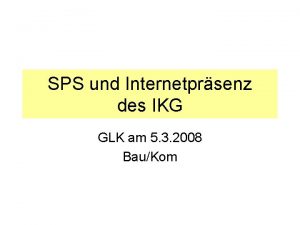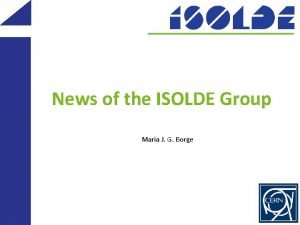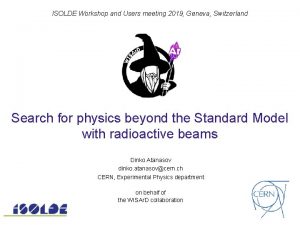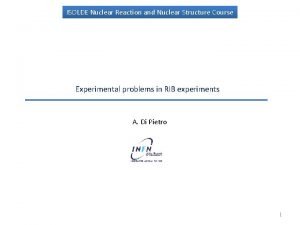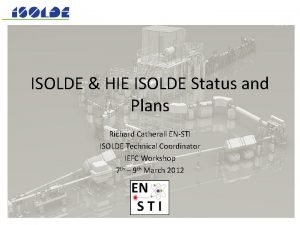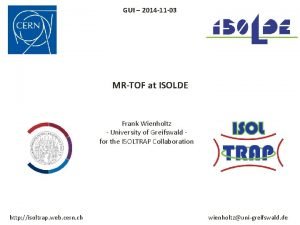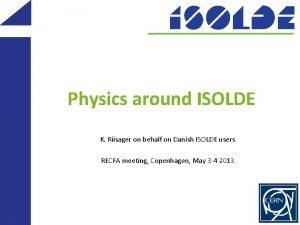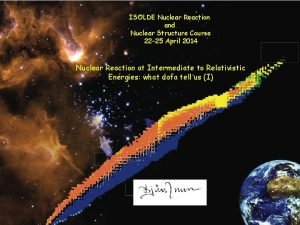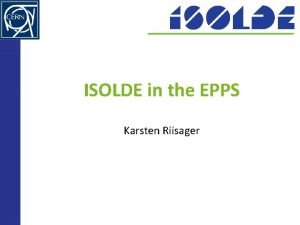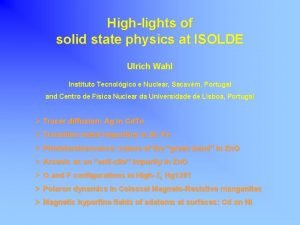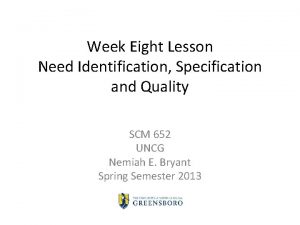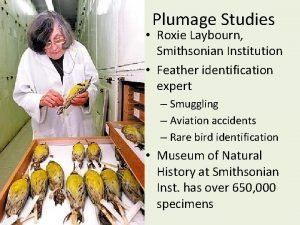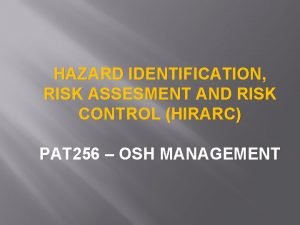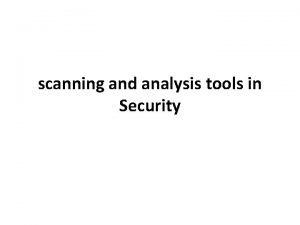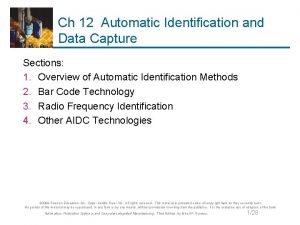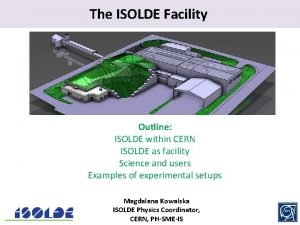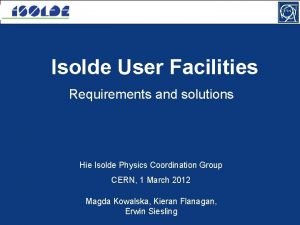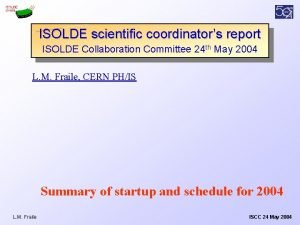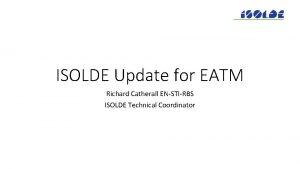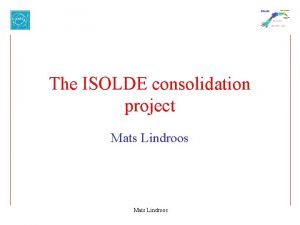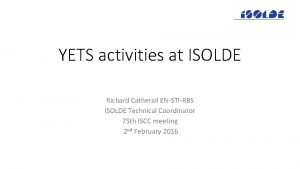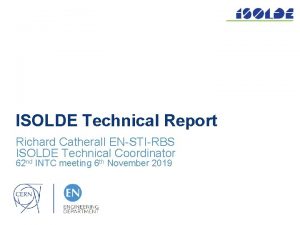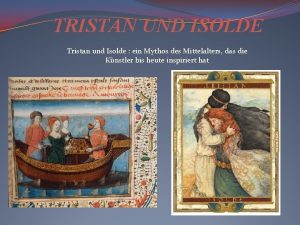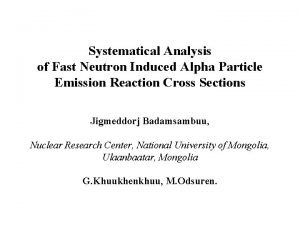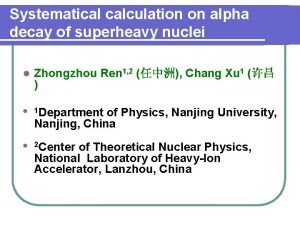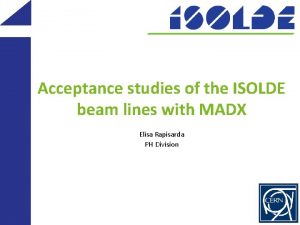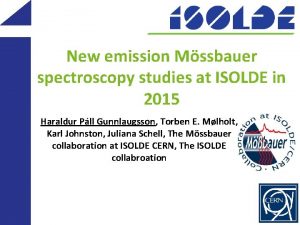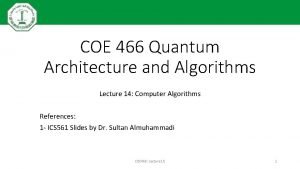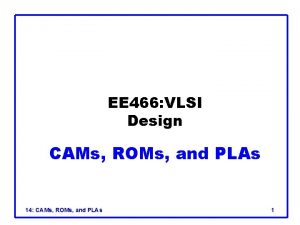ISOLDE IS 466 Identification and systematical studies of































- Slides: 31


ISOLDE IS 466: Identification and systematical studies of the electron-capture delayed fission (ECDF) in the lead region ECDF of 178, 180 Tl (Z=81) IS 534: Beta-delayed fission, laser spectroscopy and shape-coexistence studies with radioactive 85 At beams IS 534 (addendum): Laser spectroscopy and shape-coexistence studies with radioactive 79 Au beams


Laser Ion Source Target Hot Cavity Ion Source Extractor Mass separation Laser beams 60 k. V Protons Target A-1, Z A, Z material Isotope/isomer shift 1 ppm narrowband laser Reaction products (neutral) Experiments Ions • Scanning the laser frequency of the first/second step of the selective ionisation scheme for a particular isotope (or an isomer) • Isotope shift (IS), hyperfine structure (HFS) measurements • Measuring FC current, a/g or To. F spectra while scanning the frequency

Beta-Delayed Fission QEC(A, Z) > ~ Bf(A, Z-1)

Beta-Delayed Fission N/Z ~ 1. 22– 1. 31 192, 194, 196 At β DF 192, 194, 196 Po β DF 186, 188 Bi N/Z ~ 1. 55– 1. 59

Fragment mass distribution in b. DF of Tl isotopes (experiment) 178 Tl: 0. 1 ions/μC/s, 8 fission events PβDF (178 Tl)=0. 15(6)% 180 Tl: 1111 fission events PβDF (180 Tl)=3. 2(2)× 10 -3% corresponds to A=80(1) FWHM ≈ 9 amu A=100(1)

Fragment mass distribution in b. DF of Tl isotopes and fission barriers for Hg isotopes (theory) Model: BSM(M) Brownian shape motion on fivedimensional (5 D) potential energy surfaces in Metropolis random-walk approximation Bf, exp (model), Me. V Bf, theor Me. V 180 Hg 7. 5(1. 5) 9. 8 178 Hg ~7 9. 3 PβDF (180 Tl)theor= 2× 10 -6% PβDF (180 Tl)exp= 3. 2(2)× 10 -3% Calculated yields for four Hg isotopes at three excitation energies. For the lighter isotopes the yields become more symmetric. P. Möller, J. Randrup, A. Sierk, Phys. Rev. C 85, 024306 (2012) M. Veselsky et al. Phys. Rev. C 86, 024308 (2012)

Development and use of laser-ionized At beams at ISOLDE • Determination of optical lines and efficient photoionization scheme. First measurement of the ionization potential of the element At • Beta delayed fission of 194, 196 At • Charge radii measurement for At isotopes

Photoionization scheme for the radioactive element At At IP 532 nm 795 nm 216 nm Optimal photoionization scheme. Narrow band lasers for 1 st and 2 nd transitions

Precise determination of the Ionization Potential for the radioactive element At IP (At)=9. 317510(84) e. V

IS 534, May 2012: Mass Distributions Measurements for b. DF of 194, 196 At Energy in Si 2 (Me. V) 196 At Clear difference in energy (thus, mass) distribution between fission of 180 Hg and 194, 196 Po 180 Tl 194 At Energy in Si 2 (Me. V) Energy in Si 1 (Me. V)

Shape coexistence and charge radii in Pb region Po ISOLDE, T. Cocolios et al. , PRL 106, 052503 (2011) 85 At? Pb ISOLDE, PRL 98, 112502 (2007) H. De Witte et al. 2011: Tl isotopes: IS 511 ISOLDE and IRIS (Gatchina) ?

2012: Additional nuclear spectroscopic information from Tl isotopes decay IRIS: 30 new 189 Hg γ-lines from 189 m. Tl decay are unambiguously identified and their relative intensities are determined ISOLDE: decay schemes for some Tl isotopes are determined

Astatine HFS spectra IP 532 nm 795 nm 216 nm 1 st step is better for Δ<r 2> extraction 2 nd step is better for hfs resolution (Q and μ determination)

IS 534 October 2012: Charge radii of At isotopes

October 2012: IS 534 experiment at ISOLDE – Au isotopes • Are the light Au isotopes deformed? • What are the spins of ground and isomeric states?

IS 534: Charge Radii of Au isotopes • Deformation jump toward less deformed shapes in the light Au isotopes • Shape staggering in 178 Au (large deformation difference between 2 states)

Summary: Charge Radii in Pb region • IS/charge radii for 10 At nuclei were measured • “Back to sphericity” in the lightest Au isotopes • Magnetic/quadrupole moments will be deduced • Large amount of by-product nuclear spectroscopic information on At and Au and their daughter products


IS 534: Hyperfine Structure Scans for 177, 179 Au 177 Au Ground state spins of 177, 179 Au are narrowband (WM) measured (WM) experimentally determined as measured 1/2+ 179 Au 1/2+ calculated 179 Au 3/2+ calculated

Isomer selectivity for 197, 198 At Isomer selectivity enables us to measure masses of 197 g, 198 g. At and receive nuclear spectroscopic information for pure g. s.

Windmill System at ISOLDE A. Andreyev et al. , PRL 105, 252502 (2010) Annular Si pure 50 ke. V beam from RILIS+ISOLDE MINIBALL Ge cluster Si Annular Si Si ff 50 ke. V beam from ISOLDE C-foils 20 mg/cm 2 a ff C-foil Si detectors Setup: Si detectors from both sides of the C-foil • Large geometrical efficiency (up to 80%) • 2 fold fission fragment coincidences • ff-γ, γ-α, γ-γ, etc coincidences

In-Source Spectroscopy with MR-To. F MS Multi-reflection time-of-flight mass separator (MR-To. F MS) ~1000 revolutions, ~35 ms, m/Δm ~ 105 R. N. Wolf et al. , Nucl. Instr. and Meth. A 686, 82 -90 (2012), S. Kreim et al. , INTC-P-299, IS 518 (2011)

King plot for 216 nm and 795 nm lines in At 197 m 207 197 g 198 m 217 Isotope shift δ A, A’: Δσ for different transitions should lie on the straight line with a slope Fλ 1/ Fλ 2

Why is 1/2+ 181 Tl 177 Au a decay hindered? m~1. 6 m. N , pure sph. 3 s 1/2, (as in the heavier Tl’s) 1/2+ m~1. 1 m. N , (preliminary) mixed/def/triaxial 3 s 1/2, /d 3/2 1/2+ Plot from A. Andreyev et al. , PRC 80, 024302 (2009)

What is the ground state spin of GS+FMA: W. F. Muller et al, PRC 69, 064315 (2004) 179 Au: 1/2+, 3/2+or 5/2 -? RITU: A. Andreyev et al. , R 35 experiment (+ISOLDE data) M. Venhart et al, PLB 695, 82 (2011) 179 Au 183 m. Tl 53. 3 ms 5. 85 Me. V Extensive ISOLDE data for g. s. of 183 Tl 179 Au are available, analysis underway

What is the ground state spin of GS+FMA: F. G. Kondev et al. , PLB 512, 268 (2001) 177 Au: 1/2+ or 3/2+? SHIP: A. Andreyev et al. , PRC 80, 024302 (2009) Why is a decay of 1/2+ gs of 181 Tl hindered, HF>3? Extensive ISOLDE data for g. s. of 181 Tl are available, analysis underway

Hyperfine structure anomaly for Au isotopes

Shape Coexistence in the Pb region Pb (Z=82) g. s 0+ prolate j 0 p-0 h p 2 p-2 h h 9/2 • Pb (Z=82) g. s. : p(0 p-0 h) – spherical 186 Pb 4 p-4 h Proton pair excitations across Z=82 shell gap (neutrons are spectators): Z=82 j’ p s 1/2 d 3/2 Protons Neutrons Potential Energy Surface for 186 Pb • 1 pair excitation: p(2 p-2 h) -oblate • 2 pair excitation: p(4 p-4 h) -prolate A. Andreyev et al. Nature, 405, 430 (2000) K. Heyde et al. , Phys. Rep. 102 (1983) 291 J. L. Wood et al. , Phys. Rep. 215 (1992) 101 A. Andreyev et al. , Nature 405 (2000) 430 K. Heyde and J. Wood, Review of Modern Physics, 2012

P. Möller’s calculations (2 D projection of the total 5 D picture): symmetric valley, 90 Zr+90 Zr asymmetric valley, 80 Kr+100 Ru
 Cs 466 waterloo
Cs 466 waterloo The biba integrity model
The biba integrity model Psalm 62 liedboek
Psalm 62 liedboek P 466
P 466 600-466
600-466 Cs 466
Cs 466 Cse 466
Cse 466 Cs 466 waterloo
Cs 466 waterloo Presumptive identification vs positive identification
Presumptive identification vs positive identification Isolde yield database
Isolde yield database Sps ikg
Sps ikg Isolde maria johan
Isolde maria johan Isolde workshop
Isolde workshop Reaction structure
Reaction structure Isolde
Isolde Isolde frank
Isolde frank Isolde k
Isolde k Phys. rev. c
Phys. rev. c Karsten riisager
Karsten riisager Isolde reveal
Isolde reveal Isolde liebherr
Isolde liebherr Paradigm shift from women studies to gender studies
Paradigm shift from women studies to gender studies Need identification and specification
Need identification and specification Breeding season roxie
Breeding season roxie Research problem definition
Research problem definition What is hirarc form
What is hirarc form Shellfish identification
Shellfish identification Subject and verb identification
Subject and verb identification Scanning and analysis tools in information security
Scanning and analysis tools in information security Automatic identification and data capture pdf
Automatic identification and data capture pdf Opportunity identification and selection
Opportunity identification and selection Opportunity identification and selection
Opportunity identification and selection
